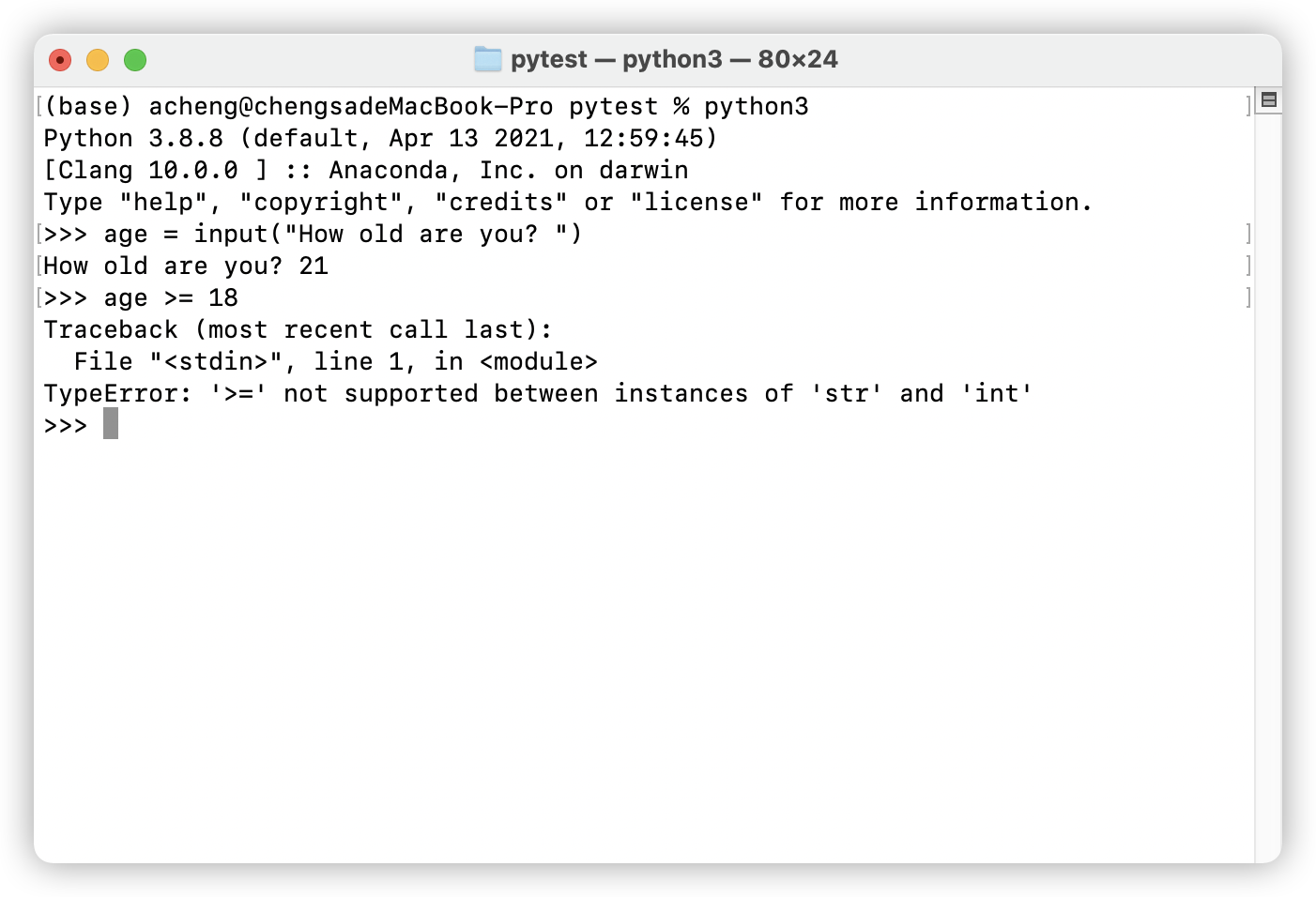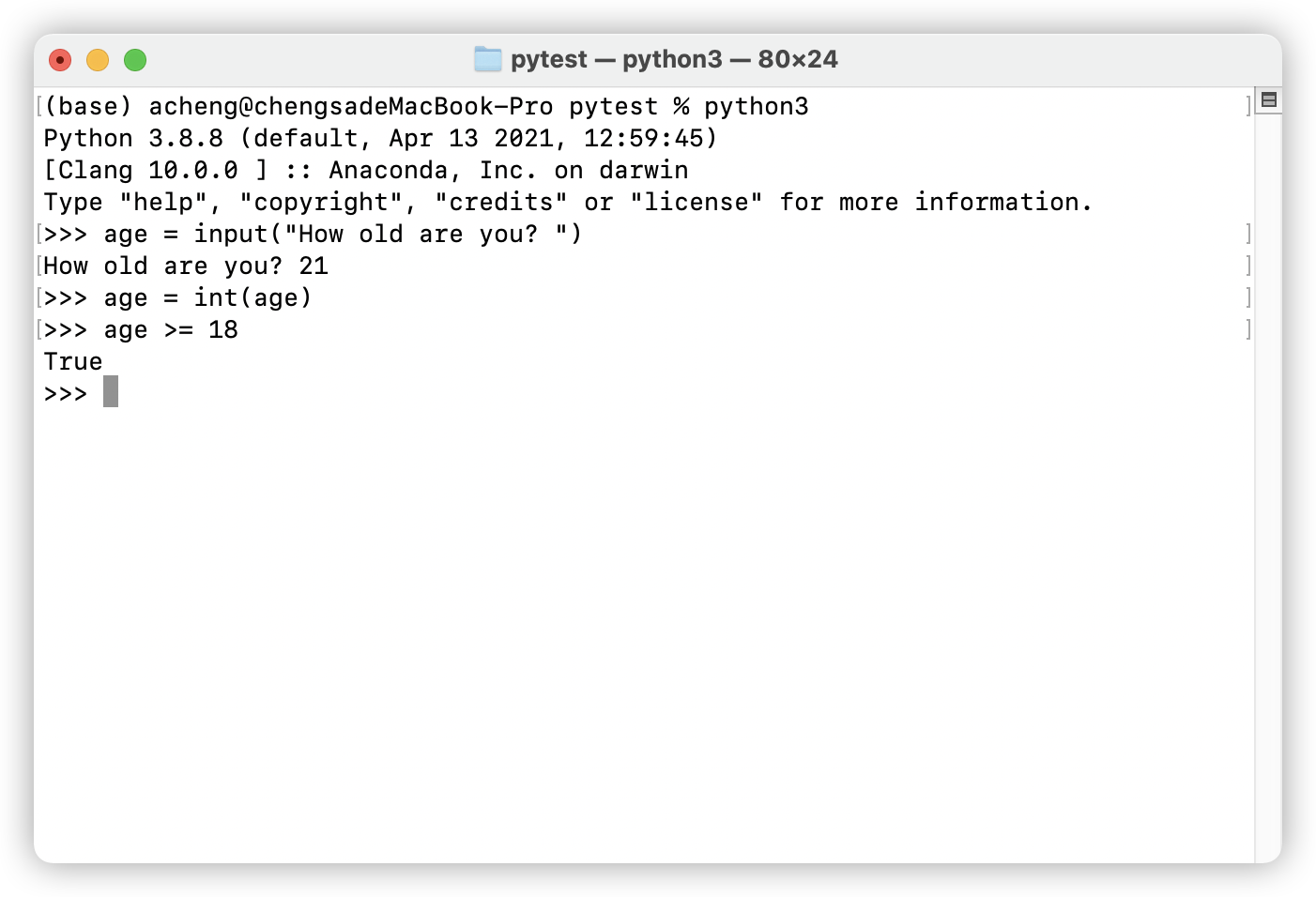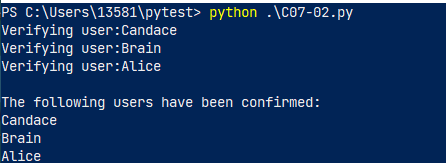input()
函数input()让程序暂停运行,等待用户输入一些文本。获取用户输入后,Python将其赋给一个变量,以方便让你使用。
例如,下面的程序让用户输入一些文本,再将这些文本呈现给用户:
message = input("Tell me something, and I will repeat it back to you: ")print(message)
函数input()接受一个参数——要向用户显示的提示(prompt)或说明,让用户知道该如何做。
通过在提示末尾(这里是冒号后面)包含一个空格,可将提示语用户输入分开,让用户情书的知道输入始于何处
有时候,提示可能超过一行,例如,你可能需要指出获取特定输入的原因。在这种情况下,可将提示赋值给一个变量,再将该变量传递给函数input()。这样,即便提示超过一行,input函数也会非常清晰:
prompt = "If you tell us who you are, we can personalize the message you see."prompt += "\nWhat is your first name? "name = input(prompt)print(f"\nHello,{name.title()}!")
使用int()来获取数值输入
使用函数input()时,Python将用户输入解读为字符串。因此如果将输入作为数来使用,就会引发错误:
为了解决这个问题,可使用函数int(),它让Python将输入视为数值。函数int()将数的字符串表示转换为数值表示
While循环
可使用while循环来数数,例如下面的循环从1数到5:
current_number= 1while current_number <= 5:print(current_number)current_number += 1
让用户选择何时退出
可以使用while循环让程序在用户愿意时不断运行,如下面的程序,我们在其中定义了一个退出值,只要用户输入的不是这个值,程序就将接着运行。
prompt = "\nTell me some thing, and I will repeat it back to you,"prompt += "\n Enter 'quit' to end the program. "message = ""while message != 'quit':message = input(prompt)# 程序将在显示消息前做简单的检查,仅在消息不是退出值时才打印它。if message != 'quit':print(message)
使用标志
在要求很多条件都满足才继续运行的程序中,可定义一个变量,用于判断整个程序是否处于活动状态。这个变量称为标志(flag),充当程序的交通信号灯。可以让程序在标志为True时继续运行,并在任何时间导致标志值为False时让程序停止运行。这样,在While语句中就只需要检查一个条件:标志的当前值是否为True。然后将所有其他测试(是否发生了应将标志设置为False的事件)都放在其他地方,从而让程序更整洁:
prompt = "\nTell me some thing, and I will repeat it back to you,"prompt += "\n Enter 'quit' to end the program. "active = Truewhile active:message = input(prompt)if message == 'quit':active = Falseelse:print(message)
将变量active设置为True,让程序最初处于活动状态。这样做简化了While语句,因为不需要在其中做任何比较——相关的逻辑由程序其他部分处理。只要变量active为True,循环就继续运行。
使用break退出循环
prompt = "\nTell me some thing, and I will repeat it back to you,"prompt += "\n Enter 'quit' to end the program. "while True:message = input(prompt)if message == 'quit':breakelse:print(message)
:::tips 在任何Python循环中都可以使用break语句。例如,可使用break语句来退出遍历列表或字典的for循环 :::
在循环中使用continue
要返回循环开头,并根据条件测试结果决定是否继续执行循环,可使用continue语句,它不像break语句那样不在执行余下的代码并退出整个循环,当执行continue语句时,Python会忽略余下的代码,并返回循环的开头。
current_number = 0while current_number < 10:current_number += 1if current_number % 2 == 0:continueprint(current_number)# 如果当前的数不能被2整除,就执行循环中余下的代码,将这个数打印出来
避免无线循环
每个程序员都会偶尔因不小心而编写出无限循环,在循环的退出条件比较微妙时尤其如此,如果程序陷入无线循环,可按Ctrl+C,也可关闭显示程序输出的终端窗口。
要避免编写无限循环,务必对每个while循环进行测试,确保其按预期那样结束。如果你希望程序在用户输入特定值时结束,可运行程序并输入这样的值。如果在这种情况下程序没有结束,请检查程序处理这个值的方式,确认程序至少有一个这样的地方能让循环条件为False,或者让break语句得以执行。
使用while循环处理列表和字典
for循环时一种遍历列表的有效方式,但不应在for循环中修改列表,否则将导致Python难以跟踪其中的元素。要在遍历列表的同时对其进行修改,可使用while循环。通过将while循环同列表和字典结合起来使用,可收集、存储并组织大量输入,供以后查看和显示。
在列表之间移动元素
# 首先,创建一个待验证用户列表和一个用于存储已验证用户的空列表unconfirmed_users = ['alice','brain','candace']confirmed_users = []# 验证每个用户,直到没有未验证用户为止,将每个经过验证的用户都移到已验证用户列表中# while循环将不断运行,直到列表 unconfirmed_users 变成空的while unconfirmed_users:current_user = unconfirmed_users.pop()print(f"Verifying user:{current_user.title()}")confirmed_users.append(current_user)# 显示所有已验证的用户print("\nThe following users have been confirmed:")for confirmed_user in confirmed_users:print(confirmed_user.title())
删除为特定值的所有列表元素
pets = ['dog', 'cat', 'dog', 'godfish', 'cat', 'rabbit', 'cat']print(pets)while 'cat' in pets:pets.remove('cat')print(pets)'''PS C:\Users\13581\pytest> python .\C07-02.py['dog', 'cat', 'dog', 'godfish', 'cat', 'rabbit', 'cat']['dog', 'dog', 'godfish', 'rabbit']'''
使用用户输入来填充字典
responses = {}#设置一个标志,指出调查是否继续polling_active = Truewhile polling_active:# 提示输入被调查者的名字和回答name = input("\nWhat is your name? ")response = input("Which mountain would you like to climb somedat? ")# 将回答存储在字典中responses[name] = response# 看看是否还有人要参与调查repeat = input("Would you like to let another person resond? (yes/no) ")if repeat == 'no':polling_active = False# 调查结束,显示结果。print("\n--- Poll Result ---")for name, response in responses.items():print(f"{name} would like to climb {response}.")



